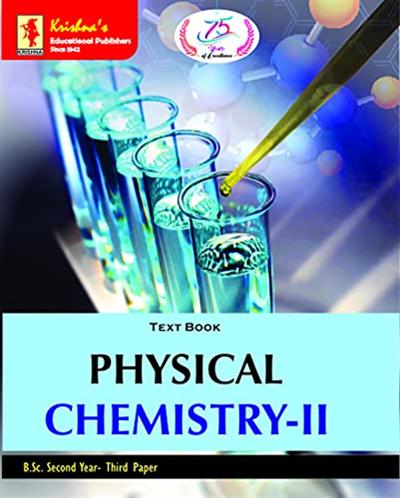
English | 2021 | ASIN: B0967286VH | 266 pages | PDF | 3.48 MB
SYLLABUS- PHYSICAL CHEMISTRY-II,
UNIT-I: (Thermodynamics & Chemical Equilibrium)
I. Thermodynamics "I
Definitions of thermodynamics terms: System, surroundings etc. Types of systems, intensive and extensive properties, state and path functions and their differentials, thermodynamic processes, concept of heat and work.
First Law of Thermodynamics: Statement, definition of internal energy and enthalpy, heat capacity, heat capacities at constant volume and pressure and their relationship, Joule's law- Joule-Thomson coefficient and inversion temperature. Calculation of w, q, dU & dH for the expansion of ideal gases under isotheral and adiabatic conditions for reversible process.
Thermochemistry: Standard state, standard enthalpy of formation- Hess's Law of heat summation and its applications, heat of reaction at constant pressure and at constant volume, enthalpy of neutralization, bond dissociation energy and its calculation from thermo-chemical data, temperature dependence of enthalpy, Kirchhoff's equation.
UNIT-II
II. Chemical Equilibrium
Equilibrium constant and free energy, Thermodynamic derivation of law of mass action, Le-Chatelier's principle. Reaction isotherm and reaction isochore- Clapeyron-clausius equation and its applications.
III. Thermodynamics-II
Second Law of Thermodynamics: Need for the law, different statements of the law, Carnot's cycle and its efficiency, Carnot's theorem. Thermodynamic scale of temperature.
Concept of entropy: Entropy as a state function, entropy as a function of V &T, entropy as a function of P & T, entropy change in physical change, clausius inequality, entropy as a criteria of spontaneity and equilibrium, equilibrium change in ideal gases and mixing of gases.
Gibbs and Helmholtz functions: Gibbs function (G) and Helmholtz function (A) as thermodynamic quantities, A & G as criteria for thermodynamic equilibrium and spontaneity, their advantage over entropy change, variation of G and A with P,V and T.
Third Law of Thermodynamics: Nernst heat theorem, statement and concept of residual entropy. Nernst distribution law- thermodynamic derivation, applications.
UNIT-III: (Electrochemistry-I & Solutions)
IV. Electrochemistry "I
Electrical transport: Conduction in metals and in electrolyte solutions, specific conductance molar and equivalent conductance, measurement of equivalent conductance, variation of molar equivalent and specific conductance with dilution.
Migration of ions and Kohlrausch's law, Arrhenius theory of electrolyte dissociation and its limitations, weak and strong electrolytes, Ostwald's dilution law its uses and limitations, Debye-Huckel-Onsager's equation for strong s electrolytes (elementary treatment only), Transport number, definition and determination by Hittorf' method and moving boundary method. Applications of conductivity measurements: determination of degree of dissociation, determination of Ka of acids, determination of solubility product of a sparingly soluble salt, conductometric titrations.
download скачать
https://nitroflare.com/view/536702B8D0FC525/rlals.Krishnas..Physical.Chemistry.II.Edition4.pdf
https://rapidgator.net/file/da1ac1b01c1da94642df760cfa0ac488/rlals.Krishnas..Physical.Chemistry.II.Edition4.pdf

